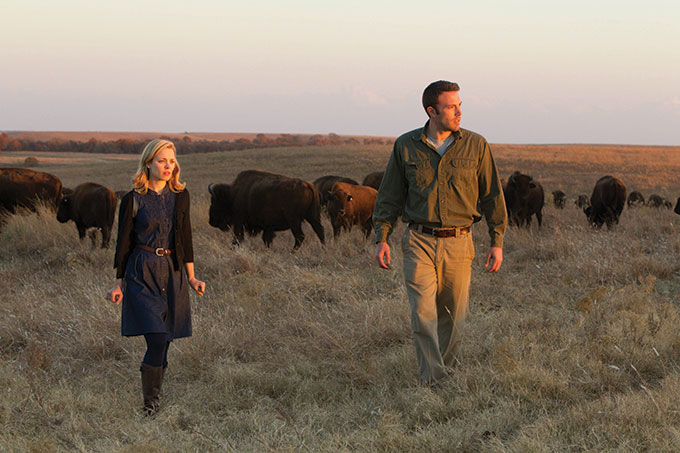To the Wonder
by Ed Grant

Emotion Capture
To the Wonder
“Life’s a dream,” remarks one character in Terrence Malick’s hypnotic new film, which functions more as a sensory experience than a conventionally plotted tale of love found and lost. It is not standard multiplex fare, but you would expect nothing less from the filmmaker who last gave us the love-it-or-hate-it masterwork Tree of Life.
To the Wonder is overwhelming in a way few modern films are. Its plotting is minimal, but its visuals are a feast—and not in the green-screen manner of so many contemporary blockbusters. Malick used CGI in Tree of Life, but one can’t imagine him releasing a 3D film—although his images often feel as if they may burst from the screen.
The film’s plot concerns an American environmental inspector (Ben Affleck) who falls in love with a Ukrainian woman living in Paris (Olga Kurylenko) and brings her back to his Oklahoma hometown (the real town of Bartlesville). The couple breaks up, then get back together and begin to seriously wonder about their compatibility. Meanwhile the local priest (Javier Bardem) suffers a crisis of faith as he tends to the poor and sick in his community.
As in Tree of Life, the storyline is not the main ingredient. Malick offers us naked emotions on screen—joy, anger, sorrow, love, betrayal. His use of flashbacks throughout make the film function as a series of memories or, more accurately, as a dream.
The exception is the priest’s storyline, which adds a glint of reality to the proceedings. Since his perfect debut film Badlands, Malick has always used locations as “characters” in his films, and here he sketches Bartlesville as a beautiful if lonely suburb. But the priest’s plotline explores the “other side of the tracks” where the poor, the disabled, and the addicted live. Jarring images of real residents from the Bartlesvillle vicinity force the viewer to sporadically waken from the “dream” of a romantic relationship.
From its ornate title onward, To the Wonder is an exercise in disjunction that produces a primal emotional response in the viewer (thus the love-it-or-hate-it status). The visuals are so kinetic and gorgeously composed, and the editing (five editors are credited) is so fluid that the film creates its own sense of time and space. It is ultimately “about” emotion and memory and what’s left when a romance goes sour.
Malick has both literary and painterly instincts. Here the former (which leans more towards poetry than fiction) is represented by a voiceover narration in French by Kurylenko; Bardem’s character contributes his reflections in Spanish and Affleck supplies a few lines in English. To add to the linguistic stew, out of a clear blue sky (and back into it) Kurylenko befriends a young Italian woman who encourages her to flee Oklahoma, all in Italian.
The voiceover keeps the film from being a silent picture, because although the characters do speak to each other, Malick rarely lets us hear both sides of a conversation—and Affleck and Kurylenko, when heard in fragments of conversation, are both speaking their native languages to each other.
Viewers expecting a standard multiplex romance may well tune out of To the Wonder for all the reasons that fans of arthouse cinema will be drawn to it. The film contains two idyllic-looking Hollywood stars—Affleck and Rachel McAdams—who are utilized for their looks rather than their acting ability. Malick’s films have contained great performances, but they have also contained plenty of actors who are “figures in a landscape.”
Those who want a straightforward love story may also be turned off or even irritated by Kurylenko’s sometimes overripe musings (“Where are we when we’re there?”) and her character’s childlike giddiness when happy and petulant behavior when mad—but, again, these are “effects” (not FX) that Malick uses in the manner of control-freak filmmakers like Kubrick (to whom he is often compared), Bresson, and Dreyer.
Those cinematic masters are excellent points of reference here, because Malick injects a note of “transcendence” (Paul Schrader’s term for Bresson, Dreyer, and Ozu) into both plotlines. The lovers are happy and blissful in natural surroundings, but miserable in the closed confines of their house (barely furnished, a la Bresson and Dreyer). In addition to a sequence where Affleck refuses to pray with his temporary lover McAdams (the film’s only “certain” Christian), we have the Bardem plotline, which recalls Bresson’s Diary of a Country Priest.
Fans of Tree of Life will embrace To the Wonder. For those intimidated by Malick’s cinema, approach it as a true “emotion picture”—at times remote in meaning, but exquisite in execution and absolutely wrenching on a visual level.
Watch the trailer for To the Wonder
|
Issue Navigation> Issue Index > v12n19 (Week of Thursday, May 9) > Film Reviews > To the Wonder This Week's Issue • Artvoice Daily • Artvoice TV • Events Calendar • Classifieds |









 Current Issue
Current Issue